They say… 
Best beer and travel writing award 2015, 2011 -- British Guild of Beer Writers Awards
Accredited Beer Sommelier
Writer of "Probably the best book about beer in London" - Londonist
"A necessity if you're a beer geek travelling to London town" - Beer Advocate
"A joy to read" - Roger Protz
"Very authoritative" - Tim Webb.
"One of the top beer writers in the UK" - Mark Dredge.
"A beer guru" - Popbitch.

|
Top Tastings 2010
ABV: 10%
Origin: San Marcos, California, USA
Website: www.portbrewing.com
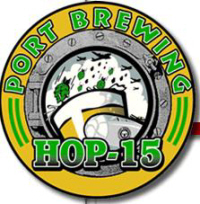 Port Hop-15 I was delighted to discover bomber bottles of this classic US imperial India pale ale on sale in outstanding London beer seller Kris Wines. The name refers to its origin as a celebration ale for the 15th anniversary of the brewery’s original location at the Pizza Port restaurant in Solana Beach, with a secret formula of 15 different hop varieties added at 15 minute intervals to the boil. The grist employs two row American pale and English light crystal barley malts.
This amber beer has a fine off-white head and a gorgeously pungent, nutty and spirity aroma with grapefruit, pine and sweet orange syrup. A thick, resinous palate is just balanced by a decent malt base, with a spicy warming quality and notes of pinoli and flowers. A long and also spicy finish has tinges of charcoal, bitter chocolate and a slow building assertive peppery note. Bitterness is complimented by plenty of complexity to keep the interest.
Read more about this beer at ratebeer.com: http://www.ratebeer.com/beer/port-brewing-hop-15/16654/
Top Tastings 2010
ABV: 4.5%
Origin: North Shields, Tyne & Wear, England
Website: www.morduebrewery.com
 Mordue Workie Ticket The Newcastle conurbation is famous for its internationally known Brown Ale, now made in Gateshead on the south bank of the Tyne, but there are far, far better beers made in the region. Several of them come from Mordue, opened by brothers Gary and Matthew Fawson in 1995 and bearing the name of a long defunct 19th century brewery that once stood on Wallsend village green. It expanded to its present site ten years later.
‘Workie ticket’ is Geordie slang for a troublemaker or awkward person, deriving from postwar usage in the Armed Forces. The expression gave its name to the brewery’s breakthrough beer, a convincing Champion Beer of Britain winner in 1997, and while it’s not exactly awkward, it’s certainly got an assertive personality, as I rediscovered over a perfect pint of the stuff at the Market Tavern during a visit to Durham.
This is a deep reddish amber beer with a thick and creamy slightly pinkish off-white head. The aroma is nutty and autumnal with jam tart hints, and a fresh smooth palate has thick, firm dry malt with a good biscuity quality, lightly acidic notes and touches of crystal malt an hops. The swallow is beautifully smooth, leading to a long, twiggy, roasty, sappy and lightly peppery finish, overall malt accented but with a fruity bramble note. Indeed the biscuity, sappy character has much in common with the brown ales of the region, although the beer is normally classed as a premium bitter. One of my favourite British cask ales.
Read more about this beer at ratebeer.com: http://www.ratebeer.com/beer/mordue-workie-ticket/5662/
Top Tastings 2010
ABV: 10%
Origin: Bodegraven, Zuid-Holland, Netherlands
Website: www.brouwerijdemolen.nl
 De Molen Hel en Verdoemenis 666 World renowned Dutch craft brewer Menno Olivier brews phenomenal beers in numerous styles, but perhaps his strongest suit is his imperial stouts, of which there are several, as well as variants within variants. ‘Hell and Damnation’ is one of them, featuring brown malts in the recipe. Batch 666 of the beer had the added twist of being matured over beechwood chips soaked in a 40-year-old Cognac and was among the rare offerings Menno brought along to the 2010 Alvinne Pré-ZBF event at Ruddervoorde.
The beer is near-black with a creamy beige head, and an iodine-like quality that leaves yellow residue on the glass. A heavily chocolate scented inky and spicy caramel-tinged aroma introduces a full, sweet coffeeish palate with raisins, plums, gravy, black treacle, brown sugar, perhaps a Cognac note and odd herbal flavours. The finish is long, warmly malty and very, very spicy with mint, caramel and more herbs. The woodchips show through on a late note with a few hop tones: sweetness provides the backbone but with a lot going on over the top of it right to the end.
Read more about this beer at ratebeer.com: http://www.ratebeer.com/beer/de-molen-hel-verdoemenis-666/118013/
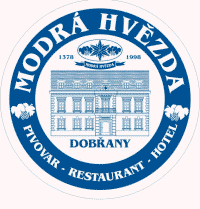 Pivovar Restaurant Hotel Modrá Hvězda Top Tastings 2010
ABV: 4.5%
Origin: Dobřany, Plzeňský Kraj, Czech Republic
Website: www.modra-hvezda.cz
Mash tuns were fired again in Dobřany, once an important brewing town a little south of Plzeň, in 1998 when the ‘Blue Star’ hotel sprouted one of the first of a new generation of microbreweries that have since done much to revitalise beer culture in the Czech Republic. The brewery is tiny but output has quadrupled over the past 15 years. I encountered its outstanding pale lager ‘Dobřany Star’ on draught at Prague’s top specialist beer pub Zlý Časy.
This unpasteurised, unfiltered beer poured a cloudy yellow-gold, with a fine, thick off-white head and a restrained cereal malt aroma with quite a worty, casky note — surprising for a lager of this type. A very fresh, soft and lightly perfurmed palate still delivered a bracing citrus kick, with complex hop flavours in the crinkles. A tasty drying hoppy finish was long and sappy over a rich cereal base. Overall, a substantial and very cheerful refresher.
Read more about this beer at ratebeer.com: http://www.ratebeer.com/beer/modra-hv283zda-12o-kvasnicove-sv283tly-lezak/36185/
Top Tastings 2010
ABV: 9.2%
Origin: Vista, California, USA
Website: www.greenflashbrew.com
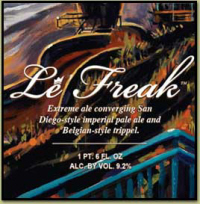 Green Flash Le Freak Founded in 2002 by former pub owners Mike and Lisa Hinkley near San Diego, joined shortly afterwards by head brewer Chuck Silva, Green Flash has established itself as a favoured source of innovative and sometimes extreme beers with the West Coast’s characteristically liberal use of hops. A self-confessed cross between a San Diego-style imperial pale ale and a Belgian tripel, Le Freak is one of the flagship products. I enjoyed a bomber of the stuff courtesy of Argonaut in Denver.
Le Freak is a peachy light amber with an orange-tinged light beige head. The aroma is flowery and herbal with fruity pale malt and a very Belgian coriander whiff. Strawberry and peach fruit offsets big resinous herbal hops on palate, with a definite perfumed tripel note. The finish is complex with grapefruit, pepper, more peach and flowery perfume and some herbal hints, very long, quite warming and finally very dry. A huge beer that achieves just what it set out to do by fusing the two styles successfully.
The brewery’s name, incidentally, refers to a meteorological phenomenon where part of the sun appears to flash a different colour, usually green, at sunrise and sunset in certain coastal areas.
Read more about this beer at ratebeer.com: http://www.ratebeer.com/beer/green-flash-le-freak/70945/
Top Tastings 2010
ABV: 9%
Origin: Horndean, Hampshire, England
 George Gale Prize Old Ale 2007 Gale’s Prize Old Ale is a real slice of British brewing heritage. Created by a Yorkshireman who worked at the company’s 1860s tower brewery in the early 20th century, it perpetuated an already declining technique in British brewing, the long ageing of strong ales which had once been a key component of porter production. When CAMRA was founded in 1971 it was one of the legendary five bottle conditioned beers still in production in the UK. Michael Jackson, in his 1993 Beer Companion, describes it as brewed in a Victorian cast iron mash tun and a copper dating from 1826, and matured for six to 12 months in glass lined cast iron tanks, before being bottled, unfiltered and unpasteurised, straight from the tank with no additional sugar or yeast, after which it can continue to mature for many years. One Gales brewer, he says, “argued that 20 years’ bottle-aging was an optimum, not a maximum.”
When Gales was bought and closed by Fuller’s in 2006, just before the final curtain the new owner farsightedly commissioned one final and specially large batch of Prize Old Ale, which was tanked to Chiswick for maturation. Some of it was then bottled and released as a 2007 vintage; some of the rest is still maturing and proportions of it are likely to appear in future Fuller’s releases of the beer. Fuller’s kindly sent me a review bottle of the 2007 which I managed to resist trying until it had at least a couple of years more of age.
The beer poured a dark red-brown with a very slight light brown head that soon subsided. Fruity, irony, cherry and chocolate aromas were reminiscent of sour Belgian ales like Rodenbach. The palate was complex, tangy and very fruity with a tasty malt body, sappy wood-like notes and big middle of chocolate and boiled sweets with a hint of hops. A lingering tangy finish yielded dates, olives, bitter herbs, nuts, vermouth and a well-balanced acidity.
That acidity, which certainly mellows but doesn’t disappear with age, has long been a noteworthy characteristic of the beer and makes me wonder about the glass lined tanks reported by Jackson, as it’s more characteristic of a wood matured beer. And indeed the 1993 account is contradicted by Fuller’s brewing director, John Keeling, who in an interview with Roger Protz says it was initially fermented in wood which was impossible to clean thoroughly, picking up the microorganisms that gave it its sourness, then matured in stainless steel tanks. Fuller’s marketing team regarded the 2007 as too aggressively sour, and had John brew a 2008 with only a small proportion of the Horndean beer, which rounds off the edges. But it’s still recognisably Prize Old Ale, now one of only two remaining of that historic 1970s five.
Read more about this beer at ratebeer.com: http://www.ratebeer.com/beer/gales-prize-old-ale/5996/
Top Tastings 2010
ABV: 5.8%
Origin: Farmville, North Carolina, USA
Website: www.duckrabbitbrewery.com
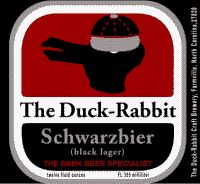 The Duck-Rabbit Schwarzbier (black lager) Only a philosopher could think to call a brewery Duck-Rabbit, after the ambiguous drawing seen as either a duck or a rabbit discussed in Ludwig Wittgenstein’s Philosophische Untersuchungen (Philosophical Investigations, 1953). And sure enough founder Paul Philippon was an academic and Wittgenstein specialist before opening the brewery in 2004. What had also piqued my interest when I heard about the brewery was that it specialised in dark beers, matching my own personal preferences, so I was delighted to find it well represented with various stouts and porters and this black lager at 2010’s Great American Beer Festival.
The beer is a very dark chestnut-brown, only a shade above black, with a light off-white trace of a head and a very chocolatey, slightly fruity aroma. there’s a medium-roast coffee palate that’s full of chewy, silky malt, yielding a bitterish burr. A crisp, roasty but smooth and soothing finish has lingering roast and lightly smoky notes. An excellent beer to get you thinking.
Read more about this beer at ratebeer.com: http://www.ratebeer.com/beer/the-duck-rabbit-schwarzbier/105762/
Top Tastings 2010
ABV: 5.3%
Origin: Aurora, Colorado, USA
Website: www.drydockbrewing.com
 Dry Dock Brewing Kevin DeLange already owned a small homebrew store when in 2005 he decided to add a microbrewery with its own tiny taproom. Such was the success of this move that in 2009 the taproom and brewery relocated to a bigger space a few doors down on the same strip mall, its popularity immensely boosted through being named Small Brewing Company of the Year at the 2009 Great American Beer Festival. Some of Dry Dock’s individual beers were honoured at the same time, including this one which won a gold medal in the Altbier class. I caught up with it at the following year’s GABF, where it won a silver medal.
The beer is a lovely pale amber with a bubbly white head and a pineapple-tinged, biscuity, creamy and sweet aroma. There’s a delicious bite to the biscuit malt palate which also has spicy summer fruit, oranges and crisp nutty tones around the edges. A nicely dry and crisp malt finish has ripe orange notes, leaving a substantial but refreshing impression.
Read more about this beer at ratebeer.com: http://www.ratebeer.com/beer/dry-dock-bismark-alt/108998/
Top Tastings 2010
ABV: 11.5%
Origin: Esen, West-Vlaanderen, Belgium
Website: www.dedollebrouwers.be
 De Dolle Brouwers Stille Nacht Reserva 2005 An extreme development of the cult classic ‘Silent Night’ strong, sweet Christmas ale from the eccentric Dolle Brouwers, this wood aged version takes a slighty stronger implementation of the same recipe, generously hopped with Nugget and matured for 18 months in refill Bordeaux barrels. There have been other vintage dated releases since, but I found this beautifully aged 2005 on the lengthy list of mature beers at Kulminator in Antwerpen.
This is an amber beer which poured with a light foamy head. A sweet liqueurish aroma was heavy with estery fruit. The palate had a very sweet, heavy, luxuriouslly peachy broad body with notes of sherry and very ripe — not to mention rotting — fruit, with obvious alcohol and a definite woody note. Oranges, peaches and apricot liqueur emerged in a coating, lingering finish with that slightly honeyed note often found in Dolle beers. There was also a notable and very pleasing touch of acid — the wood ageing would have encouraged this and other reviewers have described more recent versions as funky and ‘bretty’, but the characteristic was relatively restrained on this sample, perhaps mellowed out by age.
Read more about this beer at ratebeer.com: http://www.ratebeer.com/beer/de-dolle-stille-nacht-special-reserva-2005/59477/
Top Tastings 2010
ABV: 27%
Origin: Boston, Massachusetts, USA
Website: www.samueladams.com
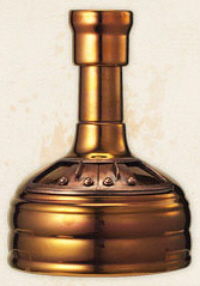 Boston Beer Company Samuel Adams Utopias 2009 I got an opportunity to try Utopias at a beer judging — it was presented anonymously but others on our judging team who’d tried it before instantly recognised it, and we later confirmed what it was, with the opportunity to taste it again. If you’re lucky enough to stumble across it — and it’s rare stuff, one of the first beers deliberately to be marketed as a premium price collectible, a limited edition retailing at up to $200 a bottle or more on the collectors’ market — you’ll realise why my colleagues found it so instantly recognisable.
The Boston Beer Company is one of the USA’s most successful and established new wave craft brewers, founded in 1985 by Jim Koch. It had already started to push the envelope with extra strong and extreme beers when it started experimenting with what became Utopias in the early 1990s, using a blend of yeasts including champagne yeast and a grist fortified with maple syrup to achieve a gravity of 24% by natural fermentation. The beer was then aged in a variety of refill barrels — Scotch whisky, bourbon, port and cognac — for up to a decade and blended to produce the first release of Utopias in 2001, distributed in a bottle designed to resemble a brewing copper.
This third version, released in 2009, has upped the gravity still further to 27% and includes a wider variety of barrel-aged beers, some of them 16 years old. Two-row pale Harrington and Metcalfe, Caramel 60, and Munich are the barley malts with a very European mix of Hallertau Mittelfrüh, Spalt and Tettnager hops. Buffalo Trace bourbon and Portugese muscatel finishing barrels have joined the ageing armoury.
The result is a completely flat iodine brown beer with no head, leaving forbidding yellow traces on the edge of the glass as it swirls. The aroma is rich and complex, with vanilla, sawn wooden boards, leather, cherries and an obvious alcoholic note. The palate is sweet and spirity with cherries, madeire fruit cake, mint and a gaseous cloud of woody retronasals. A hugely long finish has a sweet, alcoholic slick with vanilla, crackling herbal hoppy notes around the edges and the mouth coating dryness of sappy sucked wood.
I hesitated to include Utopias in this top tastings list as it’s not really like a beer at all, more like a sherry or a port, although rather more expensive than some examples of the former that are comparable in quality. But it’s certainly well worth experiencing.
Read more about this beer at ratebeer.com: http://www.ratebeer.com/beer/samuel-adams-utopias/12228/
|
Cask  This pioneering new book explains what makes cask beer so special, and explores its past, present and future. Order now from CAMRA Books. Read more here. This pioneering new book explains what makes cask beer so special, and explores its past, present and future. Order now from CAMRA Books. Read more here.
London’s Best Beer  The fully updated 3rd edition of my essential award-winning guide to London’s vibrant beer scene is available now from CAMRA Books. Read more here. The fully updated 3rd edition of my essential award-winning guide to London’s vibrant beer scene is available now from CAMRA Books. Read more here.
|














